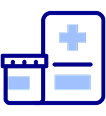






GIST diagnosis usually has the following procedures:
After the diagnosis, you should always discuss with your doctor the options that are best suited for your particular case.

Surgery could be performed in localized tumors. However, surgery might not be the best option if the GIST is too large, if there are multiple tumors that affect several organs (metastatic disease), or if the person has health issues that can make surgery risky. In those cases, surgery could be delayed or avoided.
You may have heard the terms first line, second line, etc. used when talking about drugs. These refer to the usual order of treatments, which are defined by the guidelines doctors follow. These guidelines were created over years of research. Guidelines may get updated as new treatments are established.
First line treatments are the ones used firstly.
The way the therapy interacts with the body to treat the condition, and whether the medication is designed for specific genetic mutations. Understanding its mechanism can help set expectations about its effects.

Possible adverse effects and risks associated with the medication.

How the medication is taken (e.g., pill, injection) and how often.
It is important to strictly follow what your doctor prescribed. Don't hesitate to get back to your care team if this aspect is unclear for you

The potential benefits of the treatment, including how well it worked in clinical studies.

Understanding how your treatment works, including what mutations it targets, and how it’s dosed can help you to manage GIST over time.
Even if you’ve had surgery or your cancer has responded to treatment, follow-up care remains important. Tumors can return or change, and you may need to adjust your therapy.
Key factors like safety and efficacy should be part of your ongoing conversations with your care team.
You can use these topics as a guide to prepare for your next visit, and download the discussion guide for more questions and ideas.

Side effects are possible with the treatments you’ve been prescribed for GIST. Your doctor may also be able to offer some guidance to help reduce their impact. Sometimes, it’s hard to tell if what you’re feeling is a side effect from the treatment or a symptom of the disease itself. That makes it even more important to share what you’re going through with your doctor who will help discern whether what you’re experiencing is from your treatment or not. If it is, there may be something he or she can do to help.
You can also reach out to a patient association in your country to talk, get informed and find support.
After the diagnosis, you should always discuss with your doctor the options that are best suited for your particular case.
For any drug to work, it’s important to take it exactly as it is prescribed. This is called treatment adherence. For certain drugs, this may mean taking the same dose at the same time every day.
Here are some tips on how you can achieve this.
After the diagnosis, you should always discuss with your doctor the options that are best suited for your particular case.




For any drug to work, it’s important to take it exactly as it is prescribed. This is called treatment adherence. For certain drugs, this may mean taking the same dose at the same time every day.
Here are some tips on how you can achieve this.
After the diagnosis, you should always discuss with your doctor the options that are best suited for your particular case.





Find your safe space where you can access practical resources and a community to empower you throughout your journey.